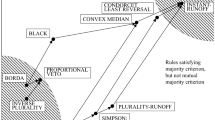Abstract
The One-man One-vote (OMOV) criterion is defined formally to demand (1) Maximum and equal voting power over the final outcome for each individual voter, and (2) Equal power-pervote for all groups of voters. We show that if it allotted Representative votes on a popular-vote-cast (rather than on the present census) basis, the Madisonian Electoral College system would assure individual voters the largest possible total power available to a “simple” system. This popular-vote basis (“MVP”) modification would relieve the present electoral impotence of voters in poorly-contested states without disturbing the voting power now enjoyed in closely-contested states.
qu]“The worth of a state, in the long run, is the worth of the individuals composing it.” John Stuart Mill
“And be these juggling fiends no more believed/That palter with us in a double sense,/That keep the word of promise to our ear,/And break it to our hope.” Shakespeare, Macbeth, Act V Scene 8.
Similar content being viewed by others
References
American Bar Association. (1967). Electing the President: A report of the Commission on Electoral College Reform. (U.S. Congress, Senate Hearings, 1977).
Banzhaf, J.F., III. (1968). One-Man, 3.312 votes: A mathematical analysis of the electoral college. Villanova Law Review, 13: 303–346 (U.S. Cong., Senate Hearings, p. 905).
Bayh, B. (1967). U.S. Cong., Senate Hearings.
Bayh, B. (1977). U.S. Cong., Senate Hearings.
FitzGerald, F. and Lelchuk, A. (1970). Vote reform: Pandora's box? Chicago Sun-Times, 27 September.
Madison, J. (1961). Federalist 10. In A. Hamilton, J. Madison, and J. Jay, Clinton Rossiter, ed. The federalist papers. New York: New American Library. (Original work published in 1788.)
Mann, I. and Shapley, L. (1960). Values of large games IV: Evaluating the electoral college by Monte Carlo techniques. Rand Research Memorandum RM-2651.
Natapoff, A. (1969). U.S. Cong., House Hearings, pp. 235–248.
Natapoff, A. (1977). U.S. Cong., Senate Hearings, pp. 368–402.
Natapoff, A. (1995). Districting increases voting power in large, block-free presidential elections: The overpowering-refinement theorem. Manuscript, in preparation.
Peirce, N. (1968). The people's president. New York: Simon and Shuster.
Riker, W. (1986). The first power index. Social Choice and Welfare 3: 293–295.
Shapley, L. and Shubik, M. (1954). A method for evaluating the distribution of power in a committee system. American Political Science Review 48: 787–792.
Shubik, M. (1964). Game theory and related approaches to social behavior. New York: Wiley.
U.S. Cong., Senate. (1966). Hearings before the subcommittee on constitutional amendments of the committee on the judiciary. Election of the president. 89th Cong., 2nd sess., and 90th Cong., 1st sess. Washington: Government Printing Office.
U.S. Cong. House. (1969). Hearings before the committee on the judiciary, House of Representatives, 91st Congress (1st session) on H.J. Res. 179, H.J. Res. 181, and similar proposals to amend the Constitution relating to electoral college Reform. Electoral college reform. Washington: Gov't Printing Office.
U.S. Cong., Senate (1977). Hearings before the committee on the judiciary, United States Senate, 95th Congress (1st session) on the electoral college and direct election of the President and Vice-President (S.J. Res. 1, 8, and 18). 27 January, 1, 2, 7, and 10 February 1977. The electoral college and direct election. Washington: Government Printing Office.
Author information
Authors and Affiliations
Rights and permissions
About this article
Cite this article
Natapoff, A. A mathematical one-man one-vote rationale for Madisonian presidential voting based on maximum individual voting power. Public Choice 88, 259–273 (1996). https://doi.org/10.1007/BF00153233
Accepted:
Issue Date:
DOI: https://doi.org/10.1007/BF00153233




